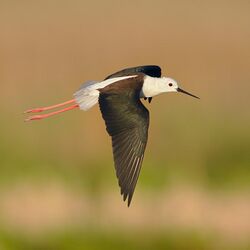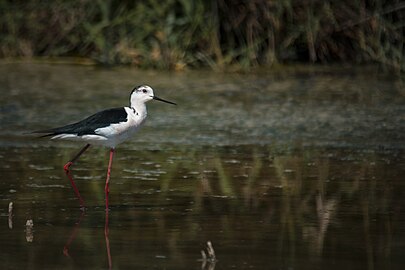Biology:Black-winged stilt
| Black-winged stilt | |
|---|---|

| |

| |
| H. h. meridionalis (South Africa ) | |
| Scientific classification | |
| Domain: | Eukaryota |
| Kingdom: | Animalia |
| Phylum: | Chordata |
| Class: | Aves |
| Order: | Charadriiformes |
| Family: | Recurvirostridae |
| Genus: | Himantopus |
| Species: | H. himantopus
|
| Binomial name | |
| Himantopus himantopus | |

| |
| Range of H. himantopus (sensu lato, see text)
Breeding Resident Passage Non-breeding
| |
| Synonyms | |
| |
The black-winged stilt (Himantopus himantopus) is a widely distributed, very long-legged wader in the avocet and stilt family Recurvirostridae. Its scientific name, Himantopus himantopus, is sometimes used to generalize a single, almost cosmopolitan species. Alternatively, it is restricted to the form that is widespread in Europe, Asia and Africa, which equals the nominate group of H. himantopus sensu lato. Meanwhile, the black-necked (H. mexicanus) and white-backed stilts (H. melanurus) both inhabit the Americas; the pied stilt (H. leucocephalus) ranges from Australasia and New Zealand. Today, most sources accept between one and four actual species.[1][2][3][4] The taxonomic name Himantopus comes from Greek, meaning "strap-foot" or "thong-foot".[5]
Description
Immature birds are grey, instead of black, and have a markedly sandy hue on their wings, with light feather fringes appearing as a whitish line in flight.
Rajasthan, India
Taxonomy and systematics
The taxonomy of this bird is still somewhat contentious; it is one of four distinct species, which sometimes are considered subspecies of H. himantopus. H. himantopus sensu lato is made up of a single species, with 5–7 subspecies, and is sometimes referred to as the common stilt. The name “black-winged stilt” refers to H. himantopus sensu stricto, with two subspecies (H.h. himantopus from the Palearctic to South Asia, and H.h. meridionalis from the Afrotropical region).[6]
Ecology and status
The breeding habitat of all these stilts is marshes, shallow lakes and ponds. Some populations are migratory and move to the ocean coasts in winter; those in warmer regions are generally resident or short-range vagrants. In Europe, the black-winged stilt is a regular spring overshoot vagrant north of its normal range, occasionally remaining to breed in northern European countries. Pairs successfully bred in Britain in 1987,[7] and after a 27-year hiatus there were two instances of successful breeding in Southern England in 2014.[8] 13 young were fledged in southern England in 2017.[9] Four chicks were successfully fledged in northern England in 2022; this is believed to be the most northerly breeding success for the black-winged stilt.[10][11]
These birds pick up their food from sand or water. They eat mainly insects and crustaceans.
The nest site is a bare spot on the ground near water. These birds often nest in small groups, sometimes with avocets.
The black-winged stilt is one of the species to which the Agreement on the Conservation of African-Eurasian Migratory Waterbirds applies.
Adults in flight
India
References
- ↑ 1.0 1.1 BirdLife International (2019). "Himantopus himantopus amends= 2016". IUCN Red List of Threatened Species 2019: e.T22727969A155440465. doi:10.2305/IUCN.UK.2019-3.RLTS.T22727969A155440465.en. https://www.iucnredlist.org/species/22727969/155440465. Retrieved 13 November 2021.
- ↑ "Species factsheet: Black-necked Stilt". BirdLife International (BLI). 2008. http://www.birdlife.org/datazone/species/index.html?action=SpcHTMDetails.asp&sid=32476&m=0.[|permanent dead link|dead link}}]
- ↑ "Species factsheet: Black-winged Stilt". BirdLife International (BLI). 2023. http://datazone.birdlife.org/species/factsheet/black-winged-stilt-himantopus-himantopus.
- ↑ "Species factsheet: White-headed Stilt". BirdLife International (BLI). 2008. http://www.birdlife.org/datazone/species/index.html?action=SpcHTMDetails.asp&sid=3102&m=0.[|permanent dead link|dead link}}]
- ↑ Jobling, James (2010). Helm Dictionary of Scientific Bird Names. London: Helm. p. 191. https://archive.org/details/Helm_Dictionary_of_Scientific_Bird_Names_by_James_A._Jobling.
- ↑ "Black-winged Stilt Himantopus himantopus (Linnaeus, 1758)". Avibase. Denis Lepage. https://avibase.bsc-eoc.org/species.jsp?avibaseid=AC6252CA7ACD600E.
- ↑ Boyd, Bill (1987). "The Black-winged Stilts at Holme Norfolk Naturalists' Trust reserve". Twitching 1 (6): 148–150.
- ↑ RSPB. "27-year first as rare black-winged stilt chicks hatch at RSPB reserves in southern England". http://www.rspb.org.uk/news/details.aspx?id=370877.
- ↑ "UK's rare black-winged stilt numbers soar". Countryfile Magazine. BBC. http://www.countryfile.com/article/uk-experiences-record-number-rare-black-winged-stilts.
- ↑ "Potteric Carr: Black-winged stilt chicks in northern first". https://www.bbc.co.uk/news/uk-england-south-yorkshire-61826871.
- ↑ "Review of the Week: 13-19 June 2022". https://www.birdguides.com/articles/review-of-the-week/review-of-the-week-13-19-june-2022/.
Further reading
- Hayman, Peter; Marchant, John; Prater, Tony (1986). Shorebirds: an identification guide to the waders of the world. Boston: Houghton Mifflin. ISBN 0-395-60237-8.
External links
| Wikimedia Commons has media related to Black-winged stilt. |
- "Black-winged stilt media". Internet Bird Collection. http://www.hbw.com/ibc/species/black-winged-stilt-himantopus-himantopus.
- Black-winged Stilt species text in The Atlas of Southern African Birds.
- Ageing and sexing (PDF; 2.7 MB) by Javier Blasco-Zumeta & Gerd-Michael Heinze
- "Himantopus himantopus". Avibase. https://avibase.bsc-eoc.org/species.jsp?lang=EN&avibaseid=.
- Black-winged stilt photo gallery at VIREO (Drexel University)
Wikidata ☰ Q178821 entry
 |


















